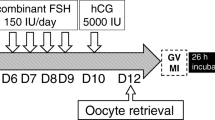Abstract
Few cases have been reported in which the aspiration of a single follicle led to the recovery of two conjoined oocytes surrounded by a single zona pellucida. This report describes a successful embryo transfer with subsequent live birth derived from conjoined oocytes, and a later pair of conjoined oocytes in the same patient. After oocyte retrieval from a patient with polycystic ovary syndrome, two pairs of conjoined oocytes were collected. One oocyte was fertilized using in vitro fertilization (IVF) and developed to the blastocyst stage. This blastocyst was cryopreserved and later transferred to the uterus after separating the unfertilized conjoined oocyte. A successful pregnancy and healthy live birth was achieved. Two years later, the patient returned for a second IVF; one pair of conjoined oocytes was detected. One of the pair was fertilized and developed to a blastocyst, but was not transferred. We demonstrate that selective fertilization of a mature oocyte from conjoined oocytes by IVF can lead to the development of a blastocyst and subsequent pregnancy and live birth. To our knowledge, this is the second case report of successful live birth from conjoined oocytes. It may be the first case of repeated fertile conjoined oocytes from the same patient.






Similar content being viewed by others
References
Zeilmaker GH, Alberda AT, van Gent I. Fertilization and cleavage of oocytes from a binovular human ovarian follicle: a possible cause of dizygotic twinning and chimerism. Fertil Steril. 1983;40:841–3.
Ben-Rafael Z, Mastroianni L Jr, Kopf GS. In vitro fertilization and cleavage of a single egg from a binovular follicle containing two individual eggs surrounded by a single zona pellucida. Fertil Steril. 1987;47:707–9.
Ron-El R, Nachum H, Golan A, Herman A, Yigal S, Caspi E. Binovular human ovarian follicles associated with in vitro fertilization: incidence and outcome. Fertil Steril. 1990;54:869–72.
Papadaki L. Binovular follicles in the adult human ovary. Fertil Steril. 1978;29:342–50.
Gougeon A. Frequent occurrence of multiovular follicles and multinuclear oocytes in the adult human ovary. Fertil Steril. 1981;35:417–22.
Vicdan K, Işik AZ, Dağli HG, Kaba A, Kişnişçi H. Fertilization and development of a blastocyst-stage embryo after selective intracytoplasmic sperm injection of a mature oocyte from a binovular zona pellucida: a case report. J Assist Reprod Genet. 1999;16:355–7.
Safran A, Reubinoff BE, Porat-Katz A, Werner M, Friedler S, Lewin A. Intracytoplasmic sperm injection allows fertilization and development of a chromosomally balanced embryo from a binovular zona pellucida. Hum Reprod. 1998;13:2575–8.
Fishel S, Kaufman MH, Jackson P, Webster J, Faratian B. Recovery of two humanoocytes surrounded by a single zona pellucida. Fertil Steril. 1989;52:325–7.
Rosenbusch B, Hancke K. Conjoined human oocytes observed during assisted reproduction: description of three cases and review of the literature. Romanian J Morphol Embryol. 2012;53:189–92.
Turkalj B, Kotanidis L, Nikolettos N. Binovular complexes after ovarian stimulation. A report of four cases. Hippokratia. 2013;17:169–70.
Cummins L, Koch J, Kilani S. Live birth resulting from a conjoined oocyte confirmed as euploid using array CGH: a case report. Reprod BioMed Online. 2016;32:62–5.
Yano K, Yano C, Kubo T, Ohashi I, Maeda N, Fukaya T. Chemical zona pellucida thinning with acidified Tyrode’s solution: comparison between partial and circumferential techniques. J Assist Reprod Genet. 2007;24:471–5.
Kuwayama M, Vajta G, Kato O, Leibo SP. Highly efficient vitrification method for cryopreservation of human oocytes. Reprod BioMed Online. 2005;11:300–8.
Yano K, Kubo T, Ohashi I, Yano C. Assisted hatching using a 1.48-μm diode laser: evaluation of zona opening and zona thinning techniques in human embryos. Reprod Med Biol. 2006;5:221–6.
Hartman CG. Polynuclear ova and polyovular follicles in the opossum and other mammals with special reference to the problem of fecundity. Am J Anat. 1926;37:1–51.
Germond M, Rink K, Nocera D, Senn A, Rink K, Delacretaz G, et al. Microdissection of mouse and human zona pelllucida using a 1.48-μm diode laser beam: efficacy and safety of the procedure. Fertil Steril. 1995;64:604–11.
Author information
Authors and Affiliations
Corresponding author
Ethics declarations
Conflict of interest
The authors declare that they have no conflicts of interest.
Human rights statements and informed consent
All procedures followed were in accordance with the ethical standards of the responsible committee on human experimentation (institutional and national) and the Helsinki Declaration of 1964 and its later amendments. Informed consent was obtained from all patients included in the study.
Animal studies
This article does not contain any studies with animal subjects performed by any of the authors.
Rights and permissions
About this article
Cite this article
Yano, K., Hashida, N., Kubo, T. et al. Repeated collection of conjoined oocytes from a patient with polycystic ovary syndrome, resulting in one successful live birth from frozen thawed blastocyst transfer: a case report. J Assist Reprod Genet 34, 1547–1552 (2017). https://doi.org/10.1007/s10815-017-1012-5
Received:
Accepted:
Published:
Issue Date:
DOI: https://doi.org/10.1007/s10815-017-1012-5




